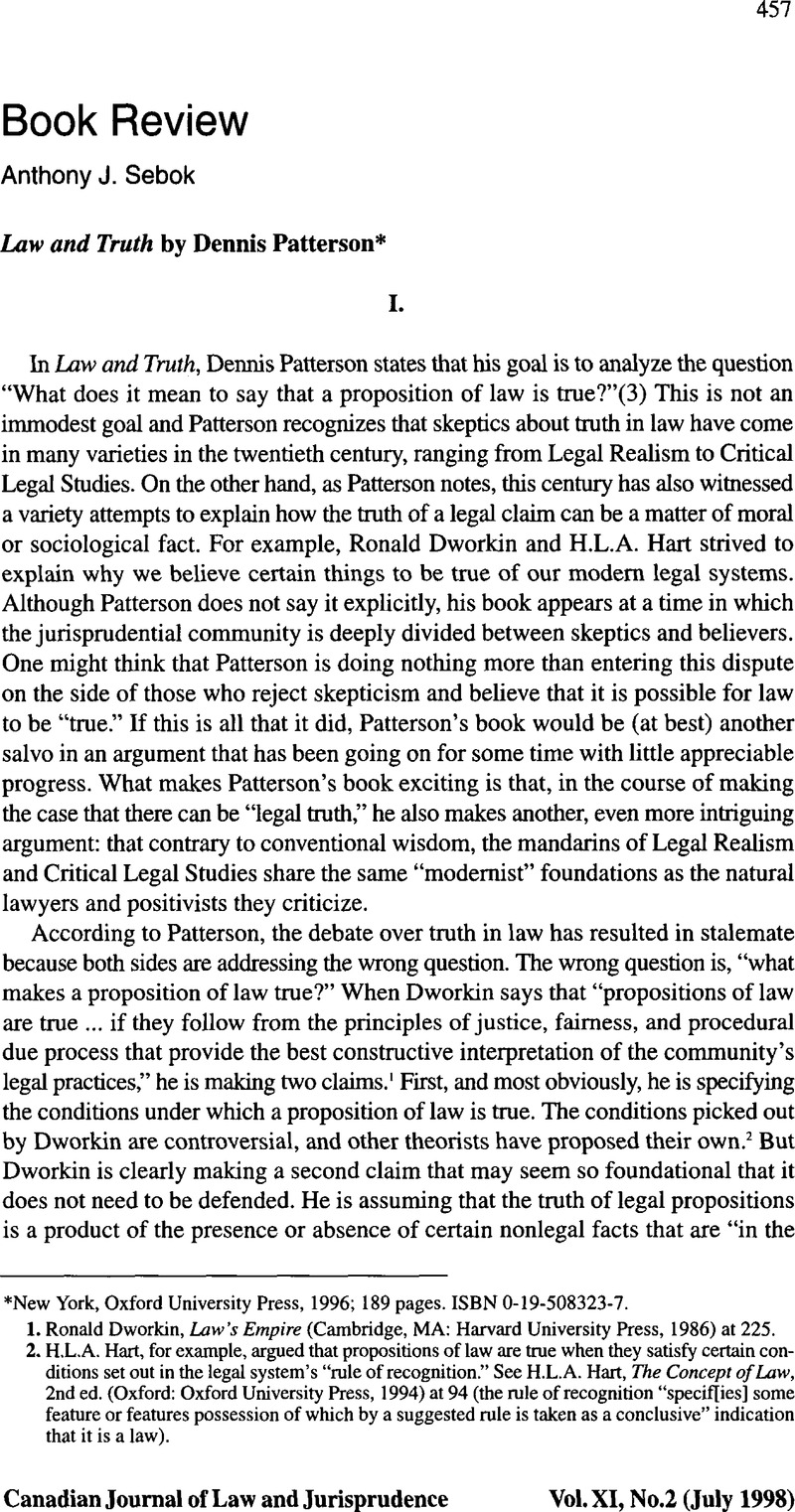No CrossRef data available.
Article contents
Abstract

- Type
- Book Review
- Information
- Copyright
- Copyright © Cambridge University Press 1998
References
* New York, Oxford University Press, 1996; 189 pages. ISBN 0-19-508323-7.
1. Ronald Dworkin, Law’s Empire (Cambridge, MA: Harvard University Press, 1986) at 225.
2. H.L.A. Hart, for example, argued that propositions of law are true when they satisfy certain conditions set out in the legal system’s “rule of recognition.” See H.L.A. Hart, The Concept of Law, 2nd ed. (Oxford: Oxford University Press, 1994) at 94 (the rule of recognition “speciffies] some feature or features possession of which by a suggested rule is taken as a conclusive” indication that it is a law).
3. Joseph Singer, “The Player and the Cards: Nihilism and Legal Theory” (1984) 94 Yale L. J. 1 at 6. Singer argued that although Critical Legal Studies believes that “legal reasoning is indeterminate … and that its claims to objectivity are false,” it does not embrace nihilism.
4. Philosophical realism should not be confused with Legal Realism; one does not entail the other, or is one inconsistent with the other.
5. Quoting D. W. Hamlyn, Metaphysics 28–29 (Cambridge: Cambridge University Press, 1984).
6. “Where the realists and the anti-realists part company is over the question whether truth conditions may … lie beyond our capacities to recognize them.” For the anti-realist, if truth conditions are nothing more than warrants for assertion in language, then “truth cannot transcend what can be warranted”(6). Quoting James O. Young, “Meaning and Metaphysical Realism” (1988) 63 Philosophy 114 at 115.
7. Citing Robert Brandom, “Truth and Assertibility” (1976) 73 J. Phil. 137.
8. That is not to say that a sentence which referred to the fact that the speaker was expressing an emotion would be meaningless. That sentence would be a meaningful statement of behaviorist psychology. But a sentence describing a sentence stating a preference is different from the sentence being described; the former should not be confused with the latter.
9. “Form is what makes something intelligible, making it what it is and distinguishing it from all other things”(25).
10. Quoting Ernest Weinrib, “Legal Formality: On the Immanent Rationality of Law” (1988) 97 Yale L.J. 949 at 961.
11. Quoting Weinrib, ibid, at 972.
12. Half of Patterson’s chapter on natural law is devoted to a discussion of David Brink, who does not embrace a representationalist view of language. Patterson acknowledges that Brink attempts to adopt a Putnamesque approach, but rejects Brink’s “natural kind semantics”(52–54).
13. “Although conventions run out… reality doesn’t run out. And it is reality, not convention, that fixes the meaning of terms [in law].” Michael Moore, “The Interpretive Turn in Modem Theory: A Turn for the Worse?” (1989) 41 S. Cal. L. Rev. 871 at 883.
14. Here Patterson sees the TCAL structure reproducing the realist/skeptic dichotomy: “For Moore, there are only two conceptions of truth … realism and anti-realism”(49).
15. “For positivists, the truth of a proposition of law turns on social facts the existence of which make the proposition in question true”(63).
16. See H.L.A. Hart, “Positivism and the Separation of Law and Morals” (1958) 71 Harv. L. Rev. 593 at 606–15.
17. “Dworkin and Fish each reduce legal understanding to an act of apprehension”(75).
18. Citing Ronald Dworkin, Introduction to The Philosophy of Law, R.M. Dworkin, ed., (Oxford: Oxford University Press, 1977) at 9.
19. “In other words, a proposition of law is true because the best political justification makes it so”(79).
20. Quoting Dworkin, supra note 1 at 52.
21. Patterson uses Putnam’s “cookie-cutter” metaphor to capture the transitive assumption built into the modernist conception: the modernist believes that “reality is something that can be captured by language much as a cookie cutter captures dough.” (167). Citing Hilary Putnam, Representation and Reality (Cambridge, MA: MIT Press, 1988) at 114.
22. “Putnam’s point is that ‘reality’ does not come prepackaged. We make sense of the world linguistically.” (169). Patterson uses Rorty to reinforce his Putnamesque point. According to Rorty, a sentence is not made true by the world in the way a blank is given form by a die: “the way in which a blank takes on the form of the die which stamps it has no analogy to the relation between the truth of a sentence and the event which the sentence is about.” (169). Quoting Richard Rorty, ‘Texts and Lumps” in 1 Philosophical Papers (Objectivity, Relativism and Truth) (Cambridge: Cambridge University Press, 1991) at 81.
23. Quoting Putnam, supra note 21 at 115.
24. Philip Bobbitt, Constitutional Interpretation (Oxford: B. Blackwell Press, 1991) at 24.
25. Bobbitt identifies six modalities: historical, textual, structural, doctrinal, ethical, and prudential. Ibid, at 12–13. Patterson seems to endorse five items on this list (excluding ‘ethical’), but the core of Patterson’s argument does not turn on the details of Bobbitt’s theory.
26. Quoting Bobbitt, ibid, at 34.
27. Ibid, at 177.
28. Even Bobbin’s final “recursion to conscience” may be seen as a final concession to the need to ground the use of state violence on something outside of the law’s own linguistic practices.


